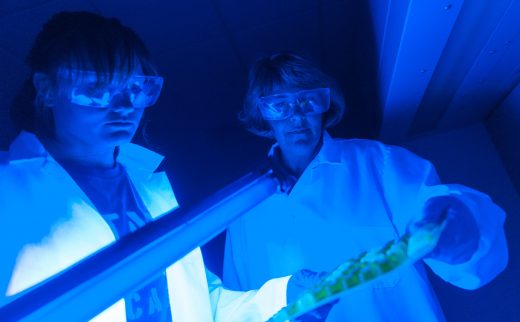Fort Riley looms large to the southwest of Manhattan, spreading over 100,000 acres and serving more than 40,000 active duty service members, their families, and other civilian employees. The base is surrounded by water: it’s sandwiched between two reservoirs – Milford and Tuttle Creek – and located along both the Republican and Kansas Rivers.
Because of this, Fort Riley was selected in 2011 to participate in the “Net Zero Initiative” as one of six Net Zero Water Pilot instillations tasked to maintain the quality and quantity of groundwater and surface water resources in the area. For K-State professor Stacy Hutchinson, this was an opportunity to evaluate the limitations and advantages of an advanced oxidation water treatment process, and assess the applications of this system using water samples from Fort Riley.

The advanced oxidation process – or AOP – is a system that uses UV irradiation and ozone to treat biologically contaminated water. The process isn’t new, but the design is unique: Hutchinson and her team wanted to make the system mobile to assist with troop security in forward deployment areas. Those troops cannot always rely on supply convoys, and often cannot transport caustic chemicals for water decontamination or carry heavy supplies of potable water. Instead, they could use the mobile AOP on water from local sources or wells, even ones contaminated with a biological agent.
Hutchinson and her team had to be certain that their AOP system could handle anything soldiers might find in their water supply. The system would have to filter water containing mud, debris, and other total suspended solids (TSS). The presence of these organic and inorganic particles in the water can affect the ability of a filtration system to properly decontaminate water samples. A system like this one must pass muster in a “real world” situation, so the research team had to find some authentic examples of exceptionally dirty water.
To do this, they turned to Fort Riley’s wash racks, which are the areas where military vehicles are washed after exercise. According to a Net Zero Fact Sheet published by the EPA, Fort Riley uses mostly recycled water to clean their military vehicles. In keeping with the Net Zero mandate of safeguarding available natural resources, water from the vehicle wash facility could be recycled for use elsewhere on the base. But, if the vehicles are ever contaminated with a chemical, biological or radiological agent, the army needs a reliable method to remove those contaminates.
Enter the mobile AOP.
The rack water provided the researchers with samples contaminated with oil, grease, metals, mud and dirt. The K-State team then used these samples, along with “clean” tap water and runoff water from a local pond, and spiked them with amounts of E.coli bacteria to find out if the AOP system could contend with elevated TSS.
Overall, the researchers established that particulates in the water weren’t a significant hindrance to their AOP system, and, by adjusting the flow rates through the AOP, they could improve the rate of inactivation of contaminates in the water. Because the mobile AOP designed in this project treats smaller volumes of wastewater, it is more cost-effective than other, larger, systems. It does, however, require a lot of energy to operate, according to Hutchinson.
Even though the government has reduced Net Zero funding, and her work on the mobile AOP has wrapped up, Hutchinson reports that K-State continues to work on wastewater treatment systems. She says the Anaerobic Membrane Bioreactor (AnMBR), has “great promise” for treating both municipal wastewater and other nutrient waste streams, such as animal agriculture wastewater. The AnMBR project, which runs through January 2018, is headed by Dr. Prathap Parameswaran, assistant professor in K-State’s Department of Civil Engineering. The work is being conducted as a subcontract to CDM-Smith Consulting.